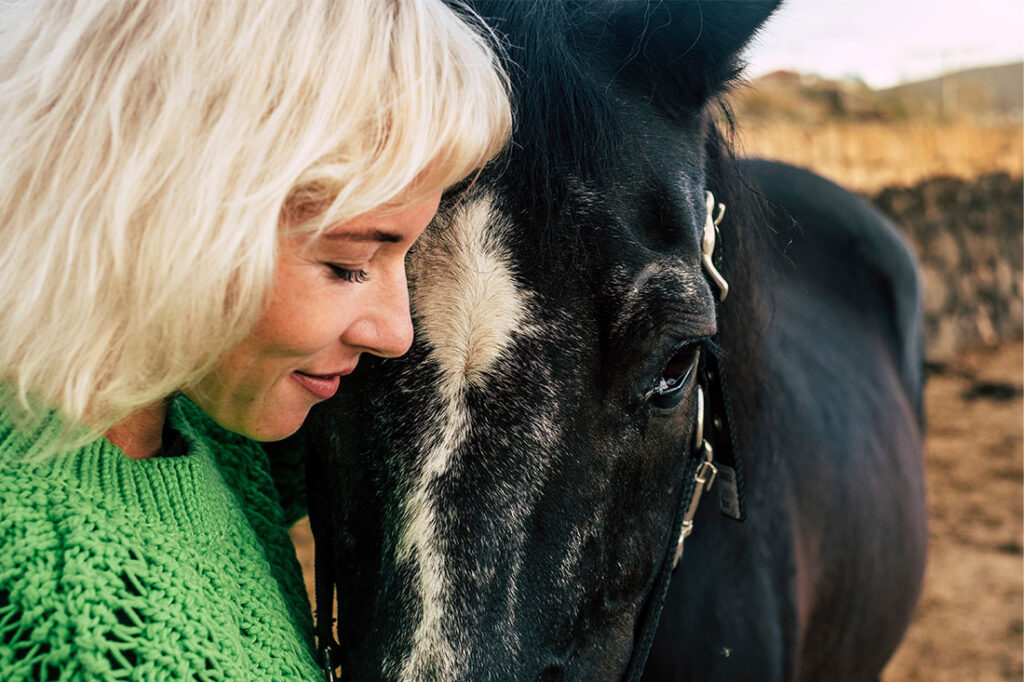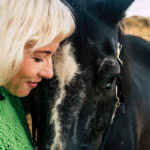On paper, the multiple car dealerships Michelle Singer manages in Queens, New York, were incredibly successful. Financially, the organization was exceeding its goals. But eight years ago, day-to-day operations told a different story.
“We were just lacking in interpersonal skills and also lacking in cooperation. Silo behavior was really, really strong,” Singer says, adding that at one point, two key managers were undermining each other instead of helping one another.
Singer decided to take her team outside its comfort zone for an experience that would help deepen self-awareness, improve communication and strengthen collaboration skills. She arranged a day working with horses in an equine-assisted learning (EAL) workshop.
“I was one of those [people] rolling my eyes [thinking] that I’m going to get in a Sprinter van with a couple of colleagues and go to a horse farm, and what the heck does this have to do with selling cars?” says Brian Benstock, who attended the event and is general manager and vice president of Paragon Honda.
Today, he continues to reference his key “aha” moments from the workshop throughout his life and in public speaking events. “Given the amount of time I’ve been talking about it, and given the number of years ago that it was, I think [Singer] genuinely believes that it made an impact, and it did,” he says.
Matt Scarchilli, an experienced sales coach and owner of Sandler Training in Albany, New York, remembers sharing Benstock’s initial thoughts when his mastermind group, which is comprised of several owners of similar-sized businesses who meet frequently to brainstorm, support and encourage one another, signed up for an EAL event in Saratoga Springs, New York.
“My first thought, honestly, was, ‘It sounds cool, and it sounds fun. I don’t really know if I’m going to learn anything,’” Scarchilli says. “There was a little bit of skepticism… because I wasn’t sure what to expect.”
One activity in Scarchilli’s experience involved leading a horse from point A to point B. Some of his colleagues had too much slack in their line and could not get the horse to budge. Scarchilli took a more firm but respectful approach and was able to guide the horse in his desired direction.
“The horse will teach you something about yourself that you probably didn’t even know,” he says. “I always knew that I led people, but I didn’t realize how, and when you get in that confined area with five people, and you get to see different… leading styles, you really get to see where you fit in and what works well and what doesn’t.”
Why horses?
Horses communicate nonverbally and depend on instant feedback from their surroundings for survival. When humans interact with horses and experience how horses communicate with one another and people, it provides a rich learning experience that allows people to learn critical emotional intelligence, or emotional quotient (EQ), skills and strategies.
Today’s executive leaders need all staff, regardless of title or position, to possess strong EQ skills. A survey by Lee Hecht Harrison Penna found that 75% of 500 people managers consider emotional intelligence when evaluating a team member for a promotion or raise.
Harvard’s Division of Continuing Education defines emotional intelligence as “a set of skills that help us recognize, understand and manage our own emotions as well as recognize, understand and influence the emotions of others.” The World Economic Forum’s Future of Jobs Report 2023 states that the skills associated with self-awareness and social influence are critical traits for success in the workforce.
Marie-Claude Stockl, a certified EAL facilitator, executive coach and cofounder of The Horse Institute in Ancramdale, New York, explains that horses have survived as prey for a long time by acquiring skills to ensure the survival of the group. “When people are around horses, solving problems, being aware of being part of a herd of horses and getting together with the horses… they begin to look to improve that peripheral vision… what’s around us, and what we can take advantage of, or just get away from,” she says.
Results from a pilot study with nurses showed that the group that participated in a one-day EAL workshop developed higher EQ skills across all dimensions measured and retained higher EQ scores six months post-event compared to the control group that did not participate in the workshop. According to the study, anecdotal evidence suggests this type of experiential learning can help to develop leadership skills, including emotional intelligence.
Because horses are prey animals, they can quickly perceive the energy another being brings to an interaction, explains Ginny Telego, a certified EAL facilitator and president and CEO of The Collaboration Partners in Ashland, Ohio.
“Horses have to be in tune with the energy of other beings… because that’s how they decide whether or not they can stay or if they need to run away,” Telego says. “Their natural ability to discern very quickly… the intention of another being… is why they’re able to be so in tune with us from an emotional intelligence place.”
EAL work takes place on the ground and each activity reveals the strengths and opportunities for growth to individuals and teams. A guided debrief follows every activity to help participants process what happened in the interaction with the horse, uncover where that shows up in their life as leaders and set goals for implementation post-event.
“When you can really learn to notice, ‘What do other people on my team need right now?’ and then, ‘How can I help with that? How can I support that?’ That’s when people start to see you as a really good leader,” Telego says.
Being seen and treated respectfully is a top concern for employees today. In an SHRM survey, 72% of employees said that “respectful treatment” of the entire workforce was a top factor in job satisfaction.
According to Telego, noticing what people might need without interpreting it through your lens of perception and assumptions makes people want to be more engaged in their work.
Being open to outcomes
Horses offer deep learning moments to individuals seeking to understand their leadership style, how others perceive it and how it impacts those they lead.
“I came to it thinking I was going to get a whole bunch about how our team works together,” says Victoria Dunn, director of impact, talent and education at a nonprofit organization in Washington, D.C. “The first interaction helped me see very clearly the things that I needed to work on in myself for how I show up as a leader and how I show up as a member of the team.”
The first activity of the workshop Dunn participated in asked each person to approach and greet a horse individually. Dunn’s assigned horse was a giant draft horse named DJ. Dunn remembers feeling confident while making her first move toward the horse. But much to her surprise, he balked.
“I moved before I had created a real connection with the horse,” she says. “It helped me very immediately, in a very tangible way, see how my impetus to move before I have all the information, or move before everyone’s ready shows up in that moment and then shows up in my work with teams generally.”
Dunn felt embarrassed and shared that she experienced “big feelings,” including feeling like she messed up and did the wrong thing. The moment she felt vulnerable, DJ stepped in between her and the rest of the team and leaned his shoulder into her to protect and support her. That experience inspired her to think and act differently.
“It helped me get clear in my communication with people… so that I’m not just moving and expecting people to come, but that I’m actually helping to create clarity and create and tap into, ‘What is people’s energy around this right now?’” she says. “It’s helped me become a more perceptive leader around clarity of focus and clarity of direction for the team.”
Changing company cultures
During Benstock’s EAL experience, the team broke into pairs and was directed to move a horse from one end of the barn to the other. The facilitator’s instructions included using all the resources available within the barn to do so. Singer and her teammate walked up to the horse, and the horse readily complied. Benstock and his partner tried tapping the horse on its rear and pulling its reins a little bit. The horse pulled back but eventually moved. The third group struggled to get the horse to cooperate, taking what Benstock says felt like an hour to move the horse.
The facilitator then asked, “Who won?” Benstock responded that Singer won because of her experience with horses and said it wasn’t fair. The facilitator then asked, “Who said it was a race?” and, “Why didn’t you ask them to help you?”
“We focused on what we couldn’t do…. We didn’t look at the human capital, the human resources that were standing right next [to us],” Benstock says. “We could have easily said to Michelle, ‘Can you help us?’… In business, I find that we are doing that all the time. We do have the [sales] floor broken up into teams, and yet, so often, those teams are running independently of one another.”
Benstock’s “aha” moment was understanding that everyone was on the same team with unlimited resources under the roof of the barn. He recounts sharing this story with a dealer he knew, who was then inspired to frame a team photo inside a barn and distribute it to several hundred of her employees. “And it had all the people in the frame of the barn, right? So all the resources,” he says.
Singer says the experience helped people stop seeing each other as the enemy. “They really took it back and shared it and had meetings with their staff and tried to trickle down the information so it would pervade the organization,” she says, noting the lasting impact the experience has had. “I’ve been around horses all my life, and I still learn things from that day.”
This article originally appeared in the January 2025 issue of SUCCESS+ digital magazine.
Photo by simona/Adobe Stock







